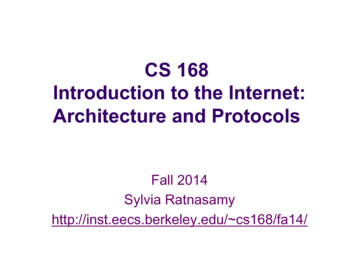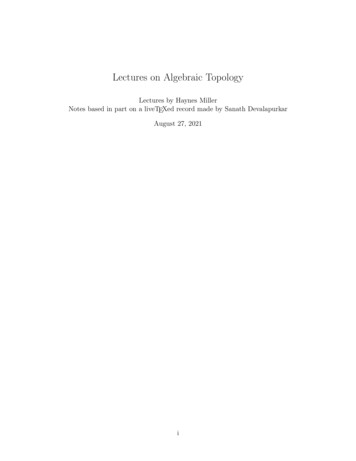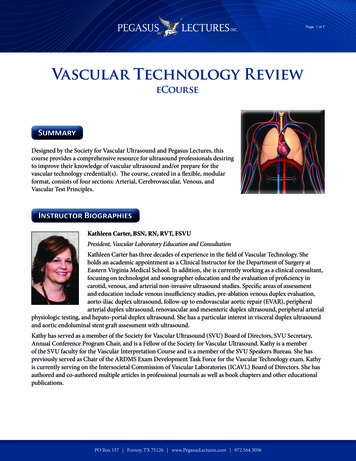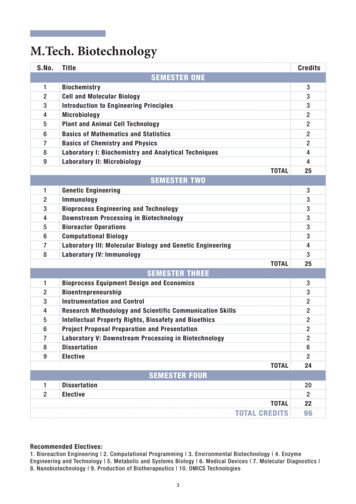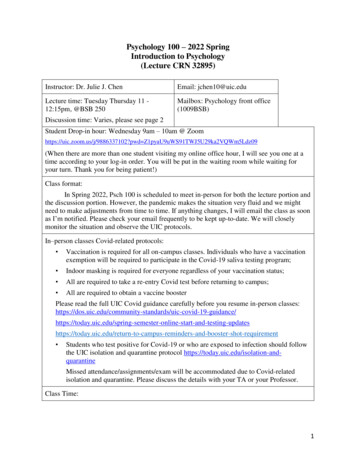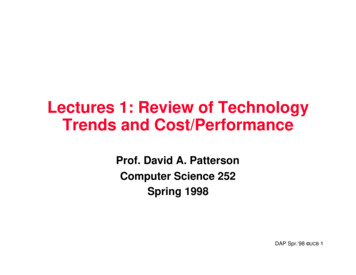
Transcription
Lectures 1: Review of TechnologyTrends and Cost/PerformanceProf. David A. PattersonComputer Science 252Spring 1998DAP Spr.‘98 UCB 1
Original Food Chain PictureBig Fishes Eating Little FishesDAP Spr.‘98 UCB 2
1988 Computer Food ChainMainframeSupercomputerMinisupercomputerWork- PCMinistationcomputerMassively ParallelProcessorsDAP Spr.‘98 UCB 3
Massively Parallel ProcessorsMinisupercomputerMinicomputer1998 Computer Food ChainMainframeServerSupercomputerWork- PCstationNow who is eating whom?DAP Spr.‘98 UCB 4
Why Such Change in 10 years? Performance– Technology Advances» CMOS VLSI dominates older technologies (TTL, ECL) incost AND performance– Computer architecture advances improves low-end» RISC, superscalar, RAID, Price: Lower costs due to – Simpler development» CMOS VLSI: smaller systems, fewer components– Higher volumes» CMOS VLSI : same dev. cost 10,000 vs. 10,000,000 units– Lower margins by class of computer, due to fewer services Function– Rise of networking/local interconnection technologyDAP Spr.‘98 UCB 5
Technology Trends:Microprocessor Capacity100000000“Graduation Window”Alpha 21264: 15 millionPentium Pro: 5.5 millionPowerPC 620: 6.9 millionAlpha 21164: 9.3 millionSparc Ultra: 5.2 million10000000TransistorsMoore’s LawPentiumi804861000000i80386i80286100000CMOS improvements: Die size: 2X every 3 yrs Line width: halve / 7 52000YearDAP Spr.‘98 UCB 6
Memory Capacity(Single Chip 8619891992199620002000size(Mb)cyc time0.0625 250 ns0.25220 ns1190 ns4165 ns16145 ns64120 ns256100 nsYearDAP Spr.‘98 UCB 7
Technology Trends(Summary)LogicCapacity2x in 3 yearsSpeed (latency)2x in 3 yearsDRAM4x in 3 years2x in 10 yearsDisk4x in 3 years2x in 10 yearsDAP Spr.‘98 UCB 8
Processor MinicomputersMicroprocessors10.11965 1970 1975 1980 1985 1990 1995 2000YearDAP Spr.‘98 UCB 9
Processor Performance(1.35X before, 1.55X now)12001000DEC Alpha 21264/6001.54X/yr800600DEC Alpha 5/5004002000DEC Alpha 5/300DECHPSunMIPSMIPSIBM 9000/AXP/DEC Alpha 4/266-4/ M M/ RS/ 750 500IBM POWER 100260 2000 120600087 88 89 90 91 92 93 94 95 96 97DAP Spr.‘98 UCB 10
Performance Trends(Summary) Workstation performance (measured in SpecMarks) improves roughly 50% per year(2X every 18 months) Improvement in cost performance estimatedat 70% per yearDAP Spr.‘98 UCB 11
Measurement and EvaluationDesignArchitecture is an iterative process: Searching the space of possible designs At all levels of computer systemsAnalysisCreativityCost /PerformanceAnalysisGood IdeasBad IdeasMediocre IdeasDAP Spr.‘98 UCB 12
Computer Architecture TopicsInput/Output and StorageDisks, WORM, TapeEmerging TechnologiesInterleavingBus tencyL2 CacheL1 CacheVLSIInstruction Set ArchitectureRAIDAddressing,Protection,Exception HandlingPipelining, Hazard Resolution,Superscalar, Reordering,Prediction, Speculation,Vector, DSPPipelining and InstructionLevel ParallelismDAP Spr.‘98 UCB 13
Computer Architecture TopicsP MP MS P MP MInterconnection rks and InterconnectionsShared Memory,Message Passing,Data ParallelismNetwork iabilityDAP Spr.‘98 UCB 14
CS 252 Course FocusUnderstanding the design techniques, machinestructures, technology factors, evaluationmethods that will determine the form ofcomputers in 21st plicationsComputer Architecture: Instruction Set Design Organization HardwareOperatingSystemsMeasurement &EvaluationInterface Design(ISA)HistoryDAP Spr.‘98 UCB 15
Topic CoverageTextbook: Hennessy and Patterson, ComputerArchitecture: A Quantitative Approach, 2nd Ed., 1996. 1.5 weeks Review: Fundamentals of Computer Architecture (Ch. 1),Instruction Set Architecture (Ch. 2), Pipelining (Ch. 3) 1 week: Pipelining and Instructional Level Parallelism (Ch. 4)2.5 weeks: Vector Processors and DSPs (Appendix B)1 week: Memory Hierarchy (Chapter 5)1.5 weeks: Input/Output and Storage (Chapter 6)1.5 weeks: Networks and Interconnection Technology (Chapter 7)1.5 weeks: Multiprocessors (Ch. 8 Culler book draft Chapter 1)Research Guest Lectures: Reconfigurable MPer(“BRASS”),DRAM MPer(“IRAM”), Systems of Systems (“Millennium”)DAP Spr.‘98 UCB 16
CS252: StaffInstructor: David A. PattersonOffice: 635 Soda Hall, 642-6587 patterson@csOffice Hours: Wed 3:30-4:30 or by appt.(Contact Tim Ryan, 643-4014, tryan@cs, 634 Soda )T. A:Joe GebisOffice: ? Soda Hall, 642-? gebis @eecsTA Office HoursClass:TBDWed, Fri 2:10:00 - 3:30:00 203 McLaughlinText:Computer Architecture: A Quantitative Approach,Second Edition (1996) ( second printing)Web page: http://http.cs.berkeley.edu/ patterson/252/Lectures available online 11:30AM day of lectureNewsgroup: ucb.class.c252DAP Spr.‘98 UCB 17
Lecture style 1-Minute Review20-Minute Lecture5- Minute Administrative Matters25-Minute Lecture5-Minute Break (water, stretch)25-Minute LectureInstructor will come to class early & stay after toanswer questionsAttention20 min.Break “In Conclusion, .”TimeDAP Spr.‘98 UCB 18
Grading 30% Homeworks (work in pairs) 30% Examinations (2 Midterms) 30% Research Project (work in pairs)–––––––––Transition from undergrad to grad studentBerkeley wants you to succeed, but you need to show initiativepick topicmeet 3 times with faculty/TA to see progressgive oral presentationgive poster sessionwritten report like conference paper 3 weeks work full time for 2 peopleOpportunity to do “research in the small” to help maketransition from good student to research colleague 10% Class ParticipationDAP Spr.‘98 UCB 19
Course Style Reduce the pressure of taking quizes––––Only 2 Graded Quizes: Wednesday Mar. 4 and Wed. Apr. 22Our goal: test knowledge vs. speed writing3 hrs to take 1.5-hr test (5:30-8:30 PM, Sibley Auditorium)Both mid-term quizes can bring summary sheet» Transfer ideas from book to paper– Last chance Q&A: during class time day of exam Students/Staff meet over free pizza/drinks at La Vals:Wed Mar. 4 (8:30 PM) and Wed Apr 22 (8:30 PM)DAP Spr.‘98 UCB 20
Course Style Everything is on the course Web page:www.cs.berkeley.edu/ pattrsn/252S98/index.html Notes:– ASUC said today that the books would be in in less than 1 week.They can also be found in local book stores (Cody's and a few inBarnes and Noble), as well as at WWW bookstores.– The Handouts section of the CS152 homepage from Fall 1997includes the midterms from this semester and as well as pointersto past exams. Solutions are included. Schedule:––––––2 Graded Quizes: Wednesday Mar. 4 and Wed. Apr. 22Project Reviews: Fri. Feb 25, Wed. Apr 1, Wed. Apr 15Oral Presentations: Thu/Fri April 30/May 1 1-7PM/1-5PM252 Poster Session: Wed May 6252 Last lecture: Fri May 8Project Papers/URLs due: Mon May 11 Project SuggestionsDAP Spr.‘98 UCB 21
Related CoursesCS 152StrongCS 252CS 258PrerequisiteHow to build itImplementation detailsBasic knowledge of theorganization of a computeris assumed!Why, Analysis,EvaluationParallel Architectures,Languages, SystemsCS 250Integrated Circuit Technologyfrom a computer-organization viewpointDAP Spr.‘98 UCB 22
Coping with CS 252 Spring 95 CS 252 my worst teaching experience Too many students with too varied background? 60 students:– To give proper attention to projects (as well as homeworks andquizes), I can handle up to 36 students Limiting Number of Students––––First priority is first year CS/ EECS grad studentsSecond priority is N-th year CS/ EECS grad studentsThird priority is College of Engineering grad studentsFourth priority is CS/EECS undegraduate seniors(Note: 1 graduate course unit 2 undergraduate course units)– All other categories If not this semester, 252 is offered regularily (Fall)DAP Spr.‘98 UCB 23
Coping with CS 252 Students with too varied background?– In past, CS grad students took written prelim exams onundergraduate material in hardware, software, and theory– 1st 5 weeks reviewed background, helped 252, 262, 270– Prelims were dropped some unprepared for CS 252? In class exam on Wednesday January 28– Doesn’t affect grade, only admission into class– 2 grades: Admitted or audit/take CS 152 1st– Improve your experience if recapture common background Review: Chapters 1- 3, CS 152 home page, maybe“Computer Organization and Design (COD)2/e”– Chapters 1 to 8 of COD if never took prerequisite– If did take a class, be sure COD Chapters 2, 6, 7 are familiar– Copies in Bechtel Library on 2-hour reserveDAP Spr.‘98 UCB 24
Computer EngineeringMethodologyTechnologyTrendsDAP Spr.‘98 UCB 25
Computer EngineeringMethodologyEvaluate ExistingSystems forBottlenecksBenchmarksTechnologyTrendsDAP Spr.‘98 UCB 26
Computer EngineeringMethodologyEvaluate ExistingSystems forBottlenecksBenchmarksTechnologyTrendsSimulate NewDesigns andOrganizationsWorkloadsDAP Spr.‘98 UCB 27
Computer uate ExistingSystems forBottlenecksBenchmarksTechnologyTrendsImplement NextGeneration SystemSimulate NewDesigns andOrganizationsWorkloadsDAP Spr.‘98 UCB 28
Measurement Tools Benchmarks, Traces, Mixes Hardware: Cost, delay, area, power estimation Simulation (many levels)– ISA, RT, Gate, Circuit Queuing Theory Rules of Thumb Fundamental “Laws”/PrinciplesDAP Spr.‘98 UCB 29
The Bottom Line:Performance (and Cost)PlaneDC to ParisSpeedPassengersThroughput(pmph)Boeing 7476.5 hours610 mph470286,700BAD/SudConcodre3 hours1350 mph132178,200 Time to run the task (ExTime)– Execution time, response time, latency Tasks per day, hour, week, sec, ns (Performance)– Throughput, bandwidthDAP Spr.‘98 UCB 30
The Bottom Line:Performance (and Cost)"X is n times faster than Y" meansExTime(Y)--------ExTime(X) Performance(X)--------------Performance(Y) Speed of Concorde vs. Boeing 747 Throughput of Boeing 747 vs. ConcordeDAP Spr.‘98 UCB 31
Amdahl's LawSpeedup due to enhancement E:ExTime w/o ESpeedup(E) ------------ExTime w/ E Performance w/ E------------------Performance w/o ESuppose that enhancement E accelerates a fraction Fof the task by a factor S, and the remainder of thetask is unaffectedDAP Spr.‘98 UCB 32
Amdahl’s LawExTimenew ExTimeold x (1 - Fractionenhanced) FractionenhancedSpeedupenhancedSpeedupoverall ExTimeoldExTimenew1 (1 - Fractionenhanced) FractionenhancedSpeedupenhancedDAP Spr.‘98 UCB 33
Amdahl’s Law Floating point instructions improved to run 2X;but only 10% of actual instructions are FPExTimenew Speedupoverall DAP Spr.‘98 UCB 34
Amdahl’s Law Floating point instructions improved to run 2X;but only 10% of actual instructions are FPExTimenew ExTimeold x (0.9 .1/2) 0.95 x ExTimeoldSpeedupoverall 10.95 1.053DAP Spr.‘98 UCB 35
Metrics of PerformanceApplicationAnswers per monthOperations per secondProgrammingLanguageCompilerISA(millions) of Instructions per second: MIPS(millions) of (FP) operations per second: MFLOP/sDatapathControlFunction UnitsTransistors Wires PinsMegabytes per secondCycles per second (clock rate)DAP Spr.‘98 UCB 36
Aspects of CPU PerformanceCPU time SecondsProgram Instructions x Cycles x SecondsProgramInstructionCycleCPIProgramInst CountXCompilerX(X)Inst. Set.XXOrganizationTechnologyXClock RateXXDAP Spr.‘98 UCB 37
Cycles Per Instruction“Average Cycles per Instruction”CPI (CPU Time * Clock Rate) / Instruction Count Cycles / Instruction CountnCPU time CycleTime * i 1CPIi* Ii“Instruction Frequency”nCPI i 1CPIi *Fiwhere Fi IiInstruction CountInvest Resources where time is Spent!DAP Spr.‘98 UCB 38
Example: Calculating CPIBase Machine (Reg / Reg)OpFreq Cycles 5(% Time)(33%)(27%)(13%)(27%)Typical MixDAP Spr.‘98 UCB 39
SPEC: System PerformanceEvaluation Cooperative First Round 1989– 10 programs yielding a single number (“SPECmarks”) Second Round 1992– SPECInt92 (6 integer programs) and SPECfp92 (14 floating pointprograms)» Compiler Flags unlimited. March 93 of DEC 4000 Model 610:spice: unix.c:/def (sysv,has bcopy,”bcopy(a,b,c) memcpy(b,a,c)”wave5: /ali (all,dcom nat)/ag a/ur 4/ur 200nasa7: /norecu/ag a/ur 4/ur2 200/lc blas Third Round 1995– new set of programs: SPECint95 (8 integer programs) andSPECfp95 (10 floating point)– “benchmarks useful for 3 years”– Single flag setting for all programs: SPECint base95,DAP Spr.‘98 UCB 40SPECfp base95
How to Summarize Performance Arithmetic mean (weighted arithmetic mean)tracks execution time: (Ti)/n or (Wi*Ti) Harmonic mean (weighted harmonic mean) ofrates (e.g., MFLOPS) tracks execution time:n/ (1/Ri) or n/ (Wi/Ri) Normalized execution time is handy for scalingperformance (e.g., X times faster thanSPARCstation 10) But do not take the arithmetic mean ofnormalized execution time,use the geometric mean ( (Ri) 1/n)DAP Spr.‘98 UCB 41
5 minute Class Break 80 minutes straight is too long for me tolecture (2:10:00 – 3:30:00):––––––– 1 minute: 20 minute 3 minutes: 25 minutes:5 minutes: 25 minutes: 1 minute:review last time & motivate this lecturelecturediscuss class manangementlecturebreaklecturesummary of today’s important topicsDAP Spr.‘98 UCB 42
SPEC First Round One program: 99% of time in single line of code New front-end compiler could improve x300eqntottlinasa7doducspiceepresso0gccSPEC Perf600BenchmarkDAP Spr.‘98 UCB 43
Impact of Means onSPECmark89 for IBM 550Ratio to ix300fpppptomcatvMeanBefore After302935344747464978 1443434404078 730908733 1385472GeometricRatio 1.33Time:Weighted Time:Before After49516567510 5104138258 140183 183282858634352019124 108ArithmeticRatio 1.16Before .866.686.683.430.372.973.072.011.9454.42 49.99Weighted Arith.Ratio1.09DAP Spr.‘98 UCB 44
Performance Evaluation “For better or worse, benchmarks shape a field” Good products created when have:– Good benchmarks– Good ways to summarize performance Given sales is a function in part of performancerelative to competition, investment in improvingproduct as reported by performance summary If benchmarks/summary inadequate, then choosebetween improving product for real programs vs.improving product to get more sales;Sales almost always wins! Execution time is the measure of computerperformance!DAP Spr.‘98 UCB 45
Integrated Circuits CostsIC cost Die cost Testing cost Packaging costFinal test yieldDie cost Wafer costDies per Wafer * Die yieldDies per wafer π * ( Wafer diam / 2)2 – π * Wafer diam – Test diesDie Area 2 * Die Area{Die Yield Wafer yield * 1 Defects per unit area * Die AreaαDie Cost goes roughly with die area4 α}DAP Spr.‘98 UCB 46
Real World ExamplesChipMetal Line Wafer Defect Area Dies/ Yield Die Costlayers width cost/cm2 mm2 wafer386DX2 0.90 9001.043 360 71% 4486DX23 0.80 12001.081 181 54% 12PowerPC 601 4 0.80 17001.3 121 115 28% 53HP PA 7100 3 0.80 13001.0 19666 27% 73DEC Alpha3 0.70 15001.2 23453 19% 149SuperSPARC 3 0.70 17001.6 25648 13% 272Pentium3 0.80 15001.5 296409% 417– From "Estimating IC Manufacturing Costs,” by Linley Gwennap,Microprocessor Report, August 2, 1993, p. 15DAP Spr.‘98 UCB 47
Cost/PerformanceWhat is Relationship of Cost to Price? Component Costs Direct Costs (add 25% to 40%) recurring costs: labor,purchasing, scrap, warranty Gross Margin (add 82% to 186%) nonrecurring costs:R&D, marketing, sales, equipment maintenance, rental, financingcost, pretax profits, taxes Average Discount to get List Price (add 33% to 66%): volumediscounts and/or retailer markupList PriceAverageDiscountAvg. Selling PriceGrossMarginDirect CostComponentCost25% to 40%34% to 39%6% to 8%15% to 33%DAP Spr.‘98 UCB 48
Chip Prices (August 1993) Assume purchase 10,000 unitsChipAreaMfg. Price Multi- Commentmm2cost43 9 313.4486DX281PowerPC 601 121 35 77 245 2803.6DEC Alpha234 202 12316.1Pentium296 473386DXplier 965Intense Competition7.0 No CompetitionRecoup R&D?2.0 Early in shipmentsDAP Spr.‘98 UCB 49
Summary: Price vs. Cost100%80%Average Discount60%Gross Margin40%Direct Costs20%Component Costs0%Mini54.743.5W/S3.82.53PC2Average DiscountGross Margin1.81.51Direct CostsComponent Costs0MiniW/SPCDAP Spr.‘98 UCB 50
Summary, #1 Designing to Last through TrendsCapacity SpeedLogicDRAM2x in 3 years4x in 3 years2x in 3 years2x in 10 yearsDisk4x in 3 years2x in 10 years6yrs to graduate 16X CPU speed, DRAM/Disk size Time to run the task– Execution time, response time, latency Tasks per day, hour, week, sec, ns, – Throughput, bandwidth “X is n times faster than Y” meansExTime(Y)--------ExTime(X) Performance(X)-------------Performance(Y)DAP Spr.‘98 UCB 51
Summary, #2 Amdahl’s Law:Speedupoverall ExTimeoldExTimenew CPI Law:CPU time SecondsProgram1 (1 - Fractionenhanced) FractionenhancedSpeedupenhanced Instructions x Cycles x SecondsProgramInstructionCycle Execution time is the REAL measure of computerperformance! Good products created when have:– Good benchmarks, good ways to summarize performance Die Cost goes roughly with die area4 Can PC industry support engineering/researchDAP Spr.‘98 UCB 52investment?
Original Food Chain Picture Big Fishes Eating Little Fishes. DAP Spr.'98 UCB 3 1988 Computer Food Chain Work-PC station . MIPS M/ 120 MIPS M 2000 1.54X/yr. DAP Spr.'98 UCB 11 . Program Program Instruction Cycle Inst Count CPI Clock Rate .
